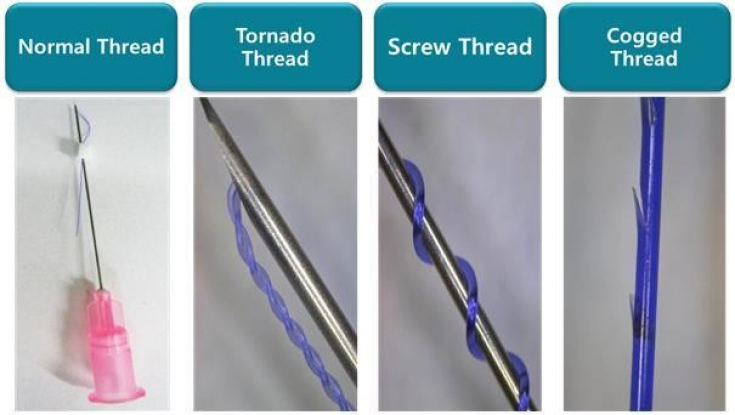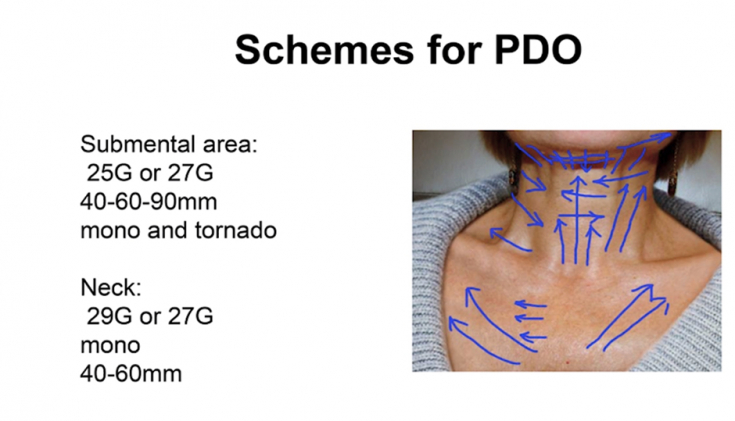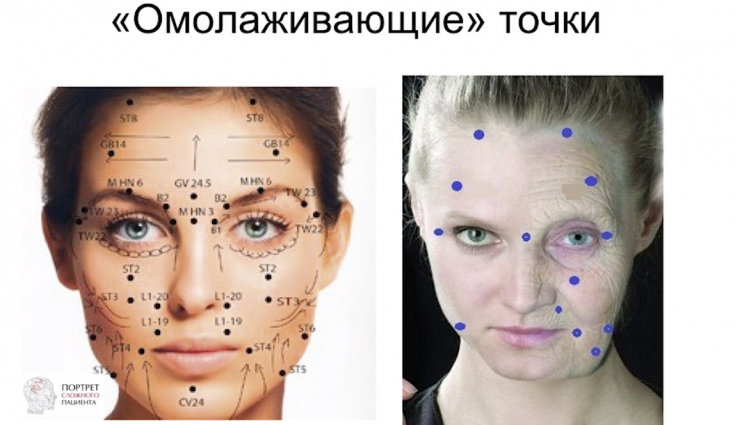What do we know about the thread lift procedure? Vladlena Averina, dermatocosmetologist, president of the Association of Aesthetic Gynecology and Andrology, scientific editor of LNE (Ukraine), member of the scientific committee of AMWC (Monaco), scientific director of the "Portrait of a Difficult Patient" series, clearly and to the point tells all the details about thread lifting: what material for threads is better to use, what indications and contraindications exist, what complications can occur, what should be expected from the procedure and how to enhance the result.
- Types of threads for thread lifting
- Thread lifting: indications, contraindications and complications
- PRP therapy to potentiate presults of thread lifting
Types of threads for thread lifting
All threads in tissues cause an aseptic inflammatory reaction, to one degree or another. Many factors contribute to tissue reactivity:
- The diameter of the thread is directly proportional to the reactivity of the thread;
- Thread configuration: monofilament (polydioxanone threads) cause less reactivity than multifilament (polyglycol threads, lactomer threads).
- The immune response determines the dissolution of the thread. Natural threads such as silk, catgut, dissolve by proteolysis, synthetic – by hydrolysis to carbon dioxide and water.
You will also be interested in: "Tandem of peels and mesotherapy. Live demonstration of 2 in 1 express procedures"
In tissues, the thread causes a reaction to a foreign body, which is accompanied by massive macrophage infiltration. Then, along the periphery, fibroblasts line up along the periphery and gradually the thread is replaced by connective tissue. In the future, it will undergo full or partial involution. After the passage of time (1.5 – 2 years), the original tissue is restored in place of the formed connective tissue or it is partially replaced by scar tissue.
Follow us on Instagram!
There are such types of threads: bioresorbable – absorbable, non-resorbable – non-absorbable. Absorbable threads are used in cosmetology. Bioresorbable include polylactic, caprolactone, polydioxanone threads. It can be smooth, interlaced threads, in the form of a spring, with notches that are applied to the fiber itself, cones, hooks. We select the appropriate thread depending on what goal we are pursuing.

Polydioxanone threads are more suitable for therapeutic purposes: to create a scaffold, tighten tissues, improve skin quality and color due to neoangiogenesis. These are monofilament mesothreads which have high sliding ability and good strength characteristics.
Read also: Mesothread tightening procedure: basics for cosmetologists
Polydioxanone threads pass through tissues more easily and provide long-lasting dermal support. 70% non-stretchability of polydioxanone threads is maintained for two weeks after setting. The resorption of such threads occurs over 180 days. Important advantages of polydioxanone as a material for threads are also low tissue reactivity (does not cause pathological scarring) in response to injection and a low risk of wound infection when using them.
Polydioxanone is an ideal material for intradermal suturing, as it provides adequate maintenance of skin biomechanics and does not cause pathological scarring.
Polydioxanone threads are injected into subcutaneous fat, the border of the dermis and hypodermis, to stimulate the formation of collagen. After the threads are inserted, a collagen matrix is formed around them. Depending on age, hormonal status, metabolism, the amount of formed collagen – different. In Ukraine, PDO threads are registered as «Implant internally based on polydioxanone, class ІІІ».
Polydioxanone threads biodegrade in two stages within 4-6 months. When applying notches in this place, the thread will be thinner, which means it will biodegrade faster. The extensibility of the thread in this case also increases. Accordingly, there can be no talk of adequate lifting. A regular thread without notches will retain its elastic properties for two months, which is necessary for neocollagenogenesis.
Polycaprolactone is a synthetic aliphatic polyester. According to American and European Pharmacopoeia, polylactic acid threads retain their length without stretching up to 240 days and are resorbed hydrolysis up to 360 days. Usually these are threads with cogami in the 3D direction. Polycaprolactone threads are more dense. They are used as tightening lifting threads.
Caprolactone threads are inserted deeper than polydioxanone threads to reposition superficial fat packs - over SMAS.
Thread lifting: indications, contraindications and complications
Depending on the aging morphotype, the volume of superficial fat pads in the finely wrinkled and deformed morphotype will differ.
In the case of finely wrinkled and muscular morphotype they are compact, in case of deformation – loose. Accordingly, in the first case, therapeutic threads are needed to stimulate collagen, and for the second – reposition of fat pads.
The more clearly we define the readings, the more effective the corrective method will be.
Indications for selecting PDO:
- Mild ptosis,
- Loss of tone and elasticity,
- Mild double chin,
- Small wrinkles,
- "Painting bags", "crows feet" in the periorbital zone,
- Strengthening the lower third of the face, neck, decollete.

As a result of the use of PDO threads , we can achieve skin tightening, slight lifting effect, improvement of skin color due to neoangiogenesis, smoothing of relief and reduction of wrinkle depth.
Indications for selecting polycaprolactone threads:
- Medium ptosis,
- Lower upper eyelid,
- Nasolabial folds and "marionette lines" that are poorly corrected with fillers,
- Blily,
- Double chin.
Follow us on Facebook!
As a result of the use of polycaprolactone threads, we can achieve the effect of lifting, tissue reposition, tissue volumization and compaction.
Contraindications for thread lifting:
- Pregnancy and lactation,
- Prone to scarring,
- Autoimmune diseases,
- Pathology of the blood coagulation system,
- Pustular, fungal, viral diseases in the area of thread insertion,
- The presence of permanent fillers in the area where the threads are inserted.
Read also: Neck Thread Lifting: Expert's Recommendations for Preparation and Rehabilitation
Before the procedure, depending on the purpose, it may be necessary to prepare the patient with mesotherapy, biorevitalization to stimulate fibroblasts before introducing a foreign body.
Dermatologist and cosmetologist Vladlena Averina does not recommend prescribing antibiotics after the thread lifting procedure when placing PDO threads.
After the thread lifting procedure complications such as prolonged swelling, translucence of the thread if you put the thread very superficially, retraction, contouring of the thread, infection, incompatibility reaction, asymmetry, violations >facial expressions (temporary or permanent).
PRP therapy to potentiate the result of a thread lift
After the thread lifting procedure, it is recommended to perform PRP – therapy to improve the result and facilitate the rehabilitation period. Most often, threads and PRP are administered in one procedure.
Read also: Plasmolifting – scope and main advantages
Mechanism of action PRP:
After activation, platelets aggregate to form a clot and begin to secrete various cytokines, adhesive proteins, and growth factors such as PDGF, activating vascular endothelial growth factor (VEGF), the primary fibroblast growth factor (bFGF), insulin-like growth factor I (IGF-I) and epidermal growth factor (EGF)
PDGF initiates healing of connective tissue, collagen matrix formation, accelerates mitogenesis, angiogenesis, macrophage activation, secretion of growth factors.

The targets for PRP are fibroblasts, muscle fibers, chondrocytes, osteoblasts, mesenchymal stem cells.
PRP enter:
- Deep in fabric,
- Surface "nappage",
- Papular, linear,
- Into a conductor with a thread,
- TO BAT,
- Into the scar tissue,
- External application (irrigation, under occlusion, on a cloth mask).
Also to potentiate the effect of thread lifting dermatocosmetologist Vladlena Averina recommends the following procedures:
- Non-crosslinked HA – 2-3 weeks before the thread lift.
- PRP – 3 weeks before the procedure, during the procedure itself, 3 weeks after threading.
- BoNT-A – 2-3 weeks before threading.
- EBD – 3-4 weeks before threading.
- TCA peel – 1 month before threading.
Thread lifting – an adequate beautiful procedure that helps to achieve the desired result and correct aesthetic imperfections. The main thing is to understand which threads should be used and what goals you are pursuing.
You will also be interested in: "Biorevitalizants. Mesocotails. Bioreparants. What is the difference, to whom and how do we prescribe?"
The article was prepared based on the materials of the webinar "Thread lifting: pros and cons" dermatologist and cosmetologist Vladlena Averina, president of the Association of Aesthetic Gynecology and Andrology, scientific editor of LNE (Ukraine), member of the scientific committee AMWC (Monaco) , Scientific Director of the Portrait of a Difficult Patient series.
More interesting stuff on our YouTube channel:







Add a comment